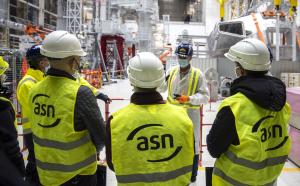Safety and the environment

As the world's largest tokamak and the first to produce a burning plasma, ITER will play an important role in demonstrating to the world that fusion technology is not only scientifically viable, but also safe and environmentally responsible. If you are asking, "Are nuclear fusion reactors safe?" please read on.
The ITER Organization passed a significant milestone in November 2012, when the decree authorizing the creation of the ITER nuclear facility was signed by the French government. This major licensing milestone was granted after years of careful examination of the ITER safety case—a detailed document of more than 5,000 pages—by the nuclear safety authorities.
For the first time in the history of fusion research, a fusion device had successfully gone through the process of nuclear licensing. Throughout construction, commissioning and operation, ITER's safety processes will comply with French regulations, as verified regularly through audit and inspection by the French nuclear authorities.
In accordance with the 2006 French law on Transparency and Nuclear Security, a Local Information Commission (Commission locale d'information, or CLI) was created for ITER in 2009. (It functioned independently until 2014, when it was reunited with the CLI Cadarache by decision of the President of the Bouches-du-Rhône Departmental Council.) This independent body acts as an interface between the ITER Organization and the local population for questions of nuclear safety, radioprotection and the installation's impact on personnel and the environment. The ITER Organization and the French Nuclear Safety Agency (ASN) provide the ITER CLI with any information necessary in the exercise of its mission. The group, which meets regularly, is composed of representatives from local government, environmental groups, trade unions, businesses and health professionals.
ITER's policy on safety, security, quality and environment protection can also be consulted here.
In ITER, a runaway reaction is impossible
It is absolutely impossible for a Fukushima-type accident to happen at ITER. The fundamental differences in the physics and technology used in fusion reactors make a fission-type nuclear meltdown or a runaway reaction impossible. The fusion process is inherently safe.
In a fusion reactor, there will only be a limited amount of fuel (less than four grams) at any given moment. The reaction relies on a continuous input of fuel; if there is any perturbation in this process and the reaction ceases immediately. Even in the event of the total loss of the cooling function, ITER's confinement barriers would not be affected. The temperatures of the vacuum vessel that provides the first confinement barrier would under no circumstances reach the melting temperatures of the materials.
Tritium and safety
The fusion process at ITER requires tritium, a radioactive form of hydrogen with a half-life of 12.3 years. Although the amount of tritium used during plasma pulses is very small—only a few grams at any one time—the confinement of this radioelement within the fuel cycle is one of the most important safety objectives at ITER.
A multiple-layer barrier system has been designed to protect against the spread or release of tritium into the environment.
Beyond the first level of the safety confinement barrier, the vacuum vessel, is a second level of security comprising the buildings and advanced detritiation systems for the recovery of tritium from gas and liquids. Where tritium is handled, an efficient static confinement barrier (air pressure cascading in the buildings) will inhibit the outward diffusion of tritium.
Even in the event of a cataclysmic breach in the tokamak, the levels of radioactivity outside the ITER enclosure would remain very low. The ITER Preliminary Safety Report presents an analysis of risks that demonstrates that during normal operation, ITER's radiological impact on the most exposed populations will be one thousand times less than natural background radiation. For postulated "worst-case scenarios," such as fire in the Tritium Plant, the evacuation of neighbouring populations would not be necessary.
No long-lived waste
Fusion reactors, unlike fission reactors, produce no high activity/long-lived radioactive waste. The "burned" fuel in a fusion reactor is helium, an inert gas. Activation produced in the material surfaces by the fast neutrons will produce waste that is classified as very low, low, or medium activity waste. All waste materials (such as components removed by remote handling during operation) will be treated, packaged, and stored on site.
Because the half-life of most radioisotopes contained in this waste is lower than ten years, within 100 years the radioactivity of the materials will have diminished in such a significant way that the materials can be recycled for use in other fusion plants. This timetable of 100 years could possibly be reduced for future devices through the continued development of 'low activation' materials, which is an important part of fusion research and development today.
Please see our FAQ section for more information on safety and the environment.
